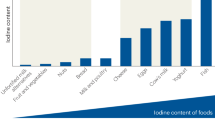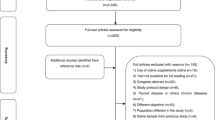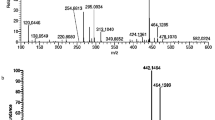Abstract
Iodine is a nutrient contributing to the development of the central nervous system. To assure a sufficient iodine intake, iodine fortification of complementary food (CF) is recommended. We describe the current fortification practice of commercial CF and formula in Germany as an example for other European countries, based on a market survey conducted in autumn 2008. In addition, we estimated the iodine intake of an 8-month-old infant, fed one portion of milk and three complementary meals per day. All formulae were fortified with iodine, and half of CF products. Iodine concentration varied depending on product groups. A partially breast-fed infant getting homemade CF reached less than 50% of the recommended iodine intake. Using infant formula and commercial CF, the recommended intake was exceeded by 39 or 100%, depending on which products were chosen. A well-balanced fortification of commercial CF, including pure infant cereals, would be required to ensure an adequate iodine supply.
This is a preview of subscription content, access via your institution
Access options
Subscribe to this journal
Receive 12 print issues and online access
$259.00 per year
only $21.58 per issue
Buy this article
- Purchase on Springer Link
- Instant access to full article PDF
Prices may be subject to local taxes which are calculated during checkout
Similar content being viewed by others
References
Agostoni C, Decsi T, Fewtrell M, Goulet O, Kolacek S, Koletzko B et al. (2008). Complementary feeding: a commentary by the ESPGHAN Committee on Nutrition. J Pediatr Gastroenterol Nutr 46, 99–110.
Alexy U, Sichert-Hellert W, Kersting M (2003). Associations between intake of added sugars and intakes of nutrients and food groups in the diets of German children and adolescents. Br J Nutr 90, 441–447.
Andersson M, de Benoist B, Delange F, Zupan J (2007). Prevention and control of iodine deficiency in pregnant and lactating women and in children less than 2-years-old: conclusions and recommendations of the Technical Consultation. Public Health Nutr 10, 1606–1611.
Berbel P, Obregon MJ, Bernal J, Escobar del Rey F, Morreale de Escobar G (2007). Iodine supplementation during pregnancy: a public health challenge. Trends Endocrinol Metab 18, 338–343.
Commission of the European Communities (2006a). Commission Directive 2006/125/EC of 5 December 2006 on processed cereal-based foods and baby foods for infants and young children. Official Journal L 339, 06/12/2006 P. 0016–0035.
Commission of the European Communities (2006b). Commission Directive 2006/141/EC of 22 December 2006 on infant formulae and follow-on formulae and amending Directive 1999/21/EC. Official Journal L 401, 30/12/2006 P. 0001–0033.
FAO/WHO (2002). Chapter 12: Iodine. In Human Vitamin and Mineral Requirements. Report of a joint FAO/WHO expert consultation. WAHO/FAO: Bangkog, Thailand.
Institute of Medicine, Food and Nutrition Board (2000). Dietary Reference Intakes for Vitamin A, Vitamin K, Arsenic, Boron, Chromium, Copper, Iodine, Iron, Manganese, Molybdenum, Nickel, Silicon, Vanadium and Zinc. National Academy Press: Washington, DC.
Leathwood P, Maier A (2005). Early influences on taste preferences. Nestle Nutr Workshop Ser Pediatr Program 56, 127–138; discussion 138–141.
Manz F (1998). Jod-Monitoring 1996. Nomos: Baden-Baden.
Untoro J, Mangasaryan N, de Benoist B, Darnton-Hill I (2007). Reaching optimal iodine nutrition in pregnant and lactating women and young children: programmatic recommendations. Public Health Nutr 10, 1527–1529.
Zimmermann MB (2007). The adverse effects of mild-to-moderate iodine deficiency during pregnancy and childhood: a review. Thyroid 17, 829–835.
Author information
Authors and Affiliations
Corresponding author
Additional information
Contributors: UA and TR conceptualize the study and were responsible for data interpretation and preparation of the manuscript; MK participated in data interpretation and manuscript preparation, CD was responsible for data collection.
Rights and permissions
About this article
Cite this article
Alexy, U., Drossard, C., Kersting, M. et al. Iodine intake in the youngest: impact of commercial complementary food. Eur J Clin Nutr 63, 1368–1370 (2009). https://doi.org/10.1038/ejcn.2009.62
Received:
Revised:
Accepted:
Published:
Issue Date:
DOI: https://doi.org/10.1038/ejcn.2009.62
Keywords
This article is cited by
-
Intake of micronutrients and fatty acids of vegetarian, vegan, and omnivorous children (1–3 years) in Germany (VeChi Diet Study)
European Journal of Nutrition (2022)
-
Sicherheit und Risiken vegetarischer und veganer Ernährung in Schwangerschaft, Stillzeit und den ersten Lebensjahren
Monatsschrift Kinderheilkunde (2019)
-
Ernährung und Bewegung von Säuglingen und stillenden Frauen
Monatsschrift Kinderheilkunde (2016)
-
Ernährung und Bewegung von Säuglingen und stillenden Frauen
Monatsschrift Kinderheilkunde (2016)
-
Beikost in Form von Breimahlzeiten oder Fingerfood
Monatsschrift Kinderheilkunde (2014)



